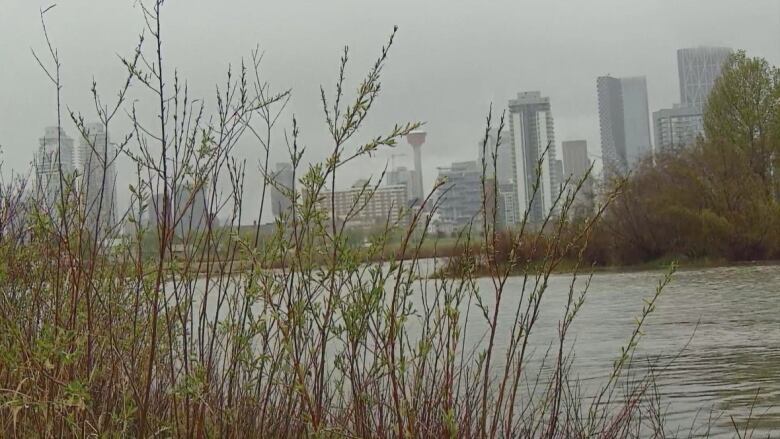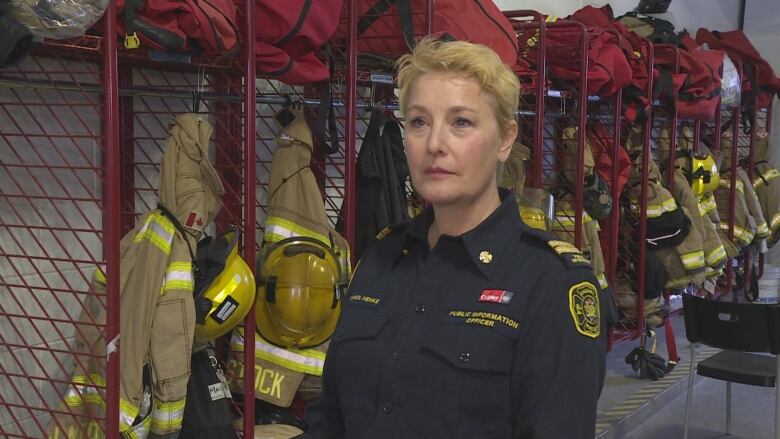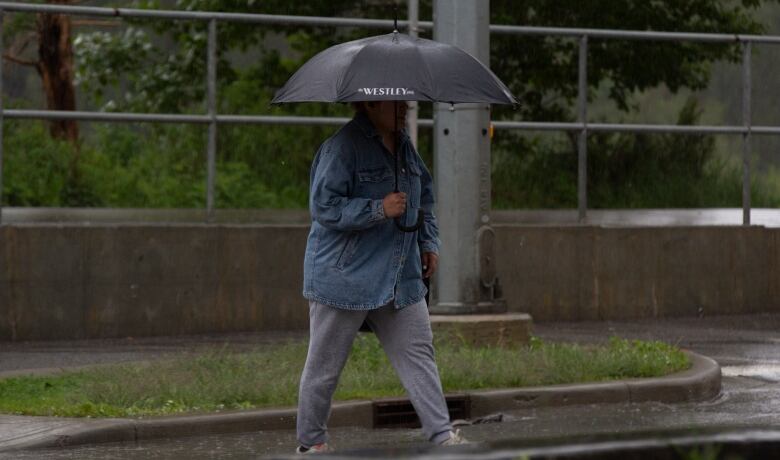Calgary and area cleaning up after days of rain and wind
City still in state of local emergency, says Mayor Jyoti Gondek

An Environment Canada rainfall warning for Calgary ended Wednesday as the city closely monitors the flood risk though themayor is asking residents to stay aware of river levels.
Though rainfall alerts were lifted for Calgary and the rest of the province Wednesday, following two days of storms, wind warnings remained in place for some areas. In Calgary, Environment Canada reported wind gusts of up to 94km/h on Wednesday.
Carol Henke, public information officer for the Calgary Fire Department, says firefighters were "incredibly busy" with the number of trees and power lines downed by gusting winds in Calgary. She says there were more than 200 calls related to the wind from Tuesday morning to Wednesday morning.
She said those figures include more than 70 hazard calls between 10:45 a.m. and 3:30 p.m. Tuesday, more than 50 electrical hazard callsand five lightning strike calls.
But despite that, shehasn't been made aware of any injuries.
"I think we are very, very lucky because with the amount of trees that have fallen, definitely that created some property damage, but that can kill someone in an instant. And we are very thankful that no injuries have been reported as a result of all of those trees down," she said.

Tuesday's wind and moisture combined with strong gusts could down trees, Henke said, advising Calgarians to remain cautious.
"Be careful when you're outside. Be aware of your surroundings and be careful when you're driving, especially if you drive a high profile vehicle because that wind can really cause havoc," she said.
The City of Calgary remains in a state of local emergency, which was implemented Monday.
"Right now, we're keeping it in place just to be overly cautious and make sure that people are protected most Calgarians know, the weather can change on a dime," Calgary Mayor Jyoti Gondek told the Calgary Eyeopener.
She also encouraged Calgarians to stay informed about what's happening in the city as river levels remain high.
"The thing that we learned in 2013 is the most important thing that we can do as a city is to communicate early and often," she said.
"Please listen to the radio. Watch television. Check the updates on the city website. Check your social media. We are trying to push out as much information as we can, and if it's going to impact people personally on their property, they will have someone from emergency services of some type come and knock on their door and tell them what they need to do."
The city closed Bowness Park, St. Patrick's Island Park and Prince's Island Park as of 4 p.m. Tuesday. It also shut down Memorial Drive at 10th Street N.W. and created a berm.

The Elbow River has reached peak flow, the city said, and isn't anticipated to rise any higher. The Bow River is expected to peak Wednesday afternoon.
The city says water levels will remain high for the coming days and can continue to change with additional weather systems.
Though it might be a tall order after two years of staying in during the pandemic, Gondek encouraged Calgarians to stay home as much as possible, off the river and its pathways.
"This will pass. But until it does, let's be safe."
In a news conference on Wednesday, Lisa Jackson with the environmental emergency management branch of Alberta Environment and Parks said they haven't received reports of any major flooding, although some localized low level flooding hasbeenreported.
All major Alberta rivershave either already peaked or will peak soon, before moving east across the province, she says.
Forecasted inflows to reservoirs dropped significantly over the past day, so Jackson says they don't have any structural or dam safety concerns. Discharges from Dickson Dam did increase on Wednesday morning, so anyone near the Red Deer River may have observed a change in water flow.
A number of provincial parks are experiencing closures as a result of the rainfall, including Bow River and Three Sisters campgrounds east of Canmore,off the Trans-Canada Highway.
Some highways are also impacted. Drivers are encouraged to check 511 for closures before heading out on the road.
The weather system is expected to drop another 5 to 20 mm of precipitation across central and southern Alberta as it makes its way out of the province Thursday.
Canmore Mayor Sean Krausert says the town is watching its bodies of water very closely, but it appears water levels may not get as high as originally anticipated.
The town, about 100 kilometres west of Calgary, activated its emergency co-ordination centre and is monitoring flow levels. Krausert says that team has been operating around the clock, and sandbags have been prepared for resident use.
"Stay calm and be thankful the rain is tapering off, and stay away from creeks and rivers. They are still flowing very strong, and banks can become unstable," he said.
Total precipitation amounts have varied across the province since Sunday afternoon.
According to Environment Canada, the Kananaskis region saw the heaviest rainfall, receiving 218 mm as of noon on Wednesday. By comparison, Olds has received 86.5 mm, while Banff has recorded 42 mm.
Environment Canada also reported a range of readings in Calgary at the airport a total of 62 mm have fallen, while the Springbank area has received 79 mm.
Environment Canada reported that thestrongest winds over the past 72 hours occurred in areasnorth of Calgary, and in the southeast corner of the province, with gusts of up to 104km/h.
'Quite a range of feelings'
Calgarian Jean Woeller owned a Sunnyside home, which was damaged by the 2013 floods. She now lives in Bowness and is president of the Bowness Responsible Flood Mitigation Society. She says it's been a busy couple of days, fielding emails from nervous residents in the community.
"There's quite a range of feelings, and it largely depends on people's experience in 2013, where they live in the community, what sort of level of property mitigation they have," she said.
"But there is some anxiety, for sure. Anxiety around the possibility of evacuation and whether there will be power loss, what the triggers might be for evacuation. There's still some unknowns. Not a lot of information has been shared in that regard."
However, she feels action taken by both the city and province has put Calgary in a better place than it was in 2013.
"And it'd be really great to hear some lessons learned after this event passes."
As of 4 p.m., Environment Canada wind warnings for much of southeastern Alberta.
With files from the Calgary Eyeopener, Dave Gilson and Taylor Simmons












_(720p).jpg)


 OFFICIAL HD MUSIC VIDEO.jpg)
.jpg)



























































































